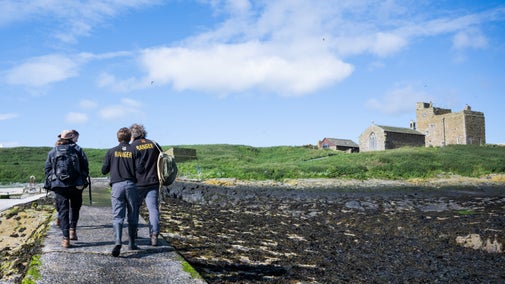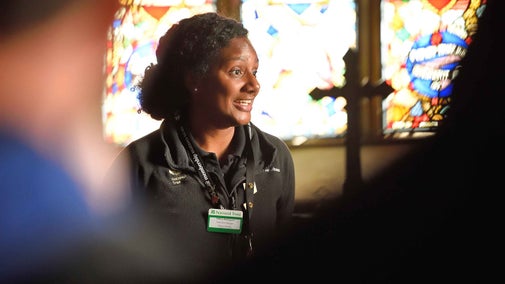
Discover more on the Farne Islands
Find out how to get to the Farne Islands, where to park, the things to see and do and more.

Discover the stories of the buildings on the Farne Islands. As the former site of a monastery complex for spiritual reflection, a defensive military outpost and several lighthouses, the Farne Islands’ position in the North Sea has made them the ideal location for a variety of structures over the centuries.
The chapel on Inner Farne was once part of a larger monastic complex which included another chapel (now the visitor centre) and surrounding courtyards.
The first structures built by the monks Aidan and Cuthbert on Inner Farne are no longer visible. But in his book Life of St Cuthbert, medieval scholar and monk the Venerable Bede gives us some clues about these early buildings. Cuthbert's cell, first built by Aidan, was made of stone and turf and was – according to Bede – 'higher than a man'.
Another larger structure, a guest house or 'hospitum', probably stood where the Fishe House is sited today.
Documents show that work began in 1369 to build a new chapel on the site of a previous building, at a cost of £50. Slightly older stone in parts of the north wall suggests that at least some of the older building was incorporated into the new structure.
The monks of the House of Farne were wealthy enough to build such structures – they cultivated crops and kept livestock on some of the other islands. The holy community continued to use the chapel until Henry VIII’s Dissolution of the Monasteries in the 16th century.
The chapel was significantly renovated in the 19th century, but we can still see reminders of earlier times.
At the chapel’s west end there are the remains of what could have been a 'Galilee' chapel, a feature common to chapels associated with St Cuthbert. And while most of the windows are from the Victorian renovation, an original medieval window remains – it's the one blocked up on the eastern end of the south wall.
The chapel also holds several medieval grave slabs which the National Trust brought in from the courtyard in 1929. Outside there’s a stone coffin which could have belonged to Thomas Sparowe, master of the House of Farne, who died in 1430.
Some of the changes made during the 19th century include the installation of the east window in 1844. This was made in Gateshead by the artist and glazier William Wailes. It was restored in 1997 by local stained-glass specialist Chris Chesney.
Although the interior wood panelling and decoration dates back further – it was designed for Bishop Cosin at Durham Cathedral in 1665 – it was brought to the Farnes in 1848. Other items such as the altar table and pews came to the chapel later from local sources.

The latest restoration project involved installing a new cross of St Cuthbert on the eastern gable. Added in 2016, it replaced a Victorian-era cross which had been badly eroded by the weather. The new cross was carved by Hexham-based stone mason David Edwick, who used photographs to copy the old design.
The most imposing building on the Farne Islands is Prior Castell's Tower, named after the Durham churchman who commissioned its construction. Like all pele towers, it was originally used to deter and defend. However, as time passed its use changed.
Thomas Castell was Prior of Durham Cathedral from 1494 to 1519 and the tower on Inner Farne was first built near the beginning of his tenure. Initially it served as accommodation for the monks and offered protection from border raids.
Following the Dissolution of the Monasteries in 1536, the tower became home to a small garrison of four men. It underwent repairs in 1566, but by 1637 the tower was in ruins and of no military use.
Its location, however, made it the ideal foundation for a beacon light. It was used this way until it was superseded in 1809 by the white round-tower lighthouse that you can see today on Inner Farne.
The islands had passed into the ownership of the Dean and Chapter of Durham at the time of the dissolution and they would lease them to suitable tenants.
As a tenant in the 1840s, Archdeacon Charles Thorp undertook a major restoration of the tower. It continued to be used intermittently until the National Trust acquired the Farne Islands in 1925.
Today the tower is home to National Trust rangers who live there for nine months of the year.

The Farne Islands extend for nearly five miles out into the North Sea and have always been a danger to ships. For this reason, many lighthouses have been built on the islands over the years and two are still in use today.
In 1669 Sir John Clayton and George Blake were given permission to erect four lighthouses along the East Coast, including on the Farne Islands. While a beacon might have been placed on top of Prior Castell’s Tower, there’s no evidence that a separate building was constructed at this time.
Over 100 years later in July 1776, the lessee of the Farnes, Captain John Blackett, was given permission to build two lighthouses at his own expense. Blackett put a couple of fire baskets on the top of the tower on Inner Farne and built a new lighthouse on Staple. Unfortunately, this lighthouse was destroyed in the Great Storm of 1784.
By 1795 a new beacon tower had been built on Brownsman. Both this and the fire baskets on Inner Farne remained in use until 1810 and 1809 respectively, when Trinity House – a charity dedicated to safeguarding shipping and seafarers – erected two new lighthouses. One was built in 1809 on Inner Farne (the High Light) and another was built on Brownsman in 1810.
Designed by Daniel Alexander, the lighthouses each had a revolving reflector that burned paraffin oil. In 1811 a further lighthouse called the Low Light was built on Inner Farne to warn of the island of Megstone.
The High Light is still in use and is a familiar landmark to all visitors today. The Low Light was pulled down in 1911 after the High Light was automated.
The Brownsman light didn’t stop the numerous wrecks to the north of this island, so in 1825 Trinity House scrapped it and built a new one on Longstone. Now automated and controlled from Harwich, this lighthouse continues to flash every 20 seconds to this day.

Find out how to get to the Farne Islands, where to park, the things to see and do and more.
Inner Farne is now closed for landings and will reopen on 1st April 2026. Find out what you might see when you take a boat trip to the Farne Islands, from wildlife such as puffins and grey seals, to centuries-old buildings including St Cuthbert's Chapel.

Find out more about how we care for Farne Islands in Northumberland, from repairing the boardwalks to surveying seals and ringing birds to track their movements.

Many people have called the Farne Islands home over the centuries, from hermits and monks to soldiers, lighthouse keepers and even shipwrecked sailors.

Learn about people from the past, discover remarkable works of art and brush up on your knowledge of architecture and gardens.
